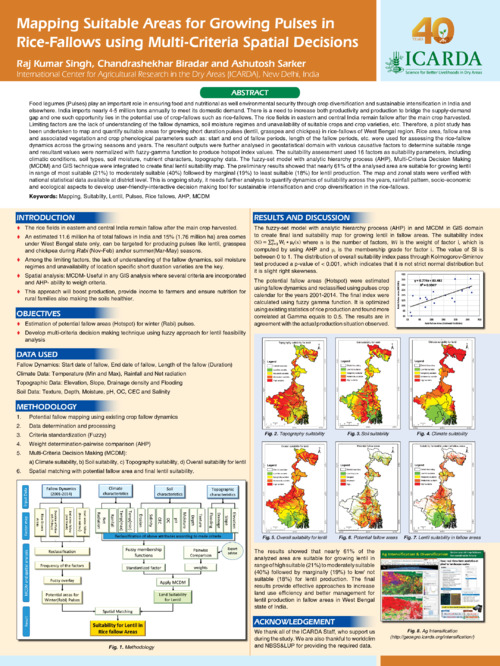Mapping Suitable Areas for Growing Pulses in Rice-Fallows using Multi-Criteria Spatial Decisions
Abstract
Food legumes (Pulses) play an important role in ensuring food and nutritional as well environmental security through crop diversication and sustainable intensification in India and elsewhere. India imports nearly 4-5 million tons annually to meet its domestic demand. There is a need to increase both productivity and production to bridge the supply-demand gap and one such opportunity lies in the potential use of crop-fallows such as rice-fallows. The rice fields in eastern and central India remain fallow after the main crop harvested. Limiting factors are the lack of understanding of the fallow dynamics, soil moisture regimes and unavailability of suitable crops and crop varieties, etc. Therefore, a pilot study has been undertaken to map and quantify suitable areas for growing short duration pulses (lentil, grasspea and chickpea) in rice-fallows of West Bengal region. Rice area, fallow area and associated vegetation and crop phenological parameters such as: start and end of fallow periods, length of the fallow periods, etc. were used for assessing the rice-fallow dynamics across the growing seasons and years. The resultant outputs were further analysed in geostatistical domain with various causative factors to determine suitable range and resultant values were normalized with fuzzy-gamma function to produce hotspot index values. The suitability assessment used 16 factors as suitability parameters, including climatic conditions, soil types, soil moisture, nutrient characters, topography data. The fuzzy-set model with analytic hierarchy process (AHP), Multi-Criteria Decision Making (MCDM) and GIS technique were integrated to create final lentil suitability map. The preliminary results showed that nearly 61% of the analysed area are suitable for growing lentil in range of most suitable (21%) to moderately suitable (40%) followed by marginal (19%) to least suitable (18%) for lentil production. The map and zonal stats were verified with national statistical data available at district level. This is ongoing study, it needs further analysis to quantify dynamics of suitability across the years, rainfall pattern, socio-economic and ecological aspects to develop user-friendly-interactive decision making tool for sustainable intensification and crop diversification in the rice-fallows

